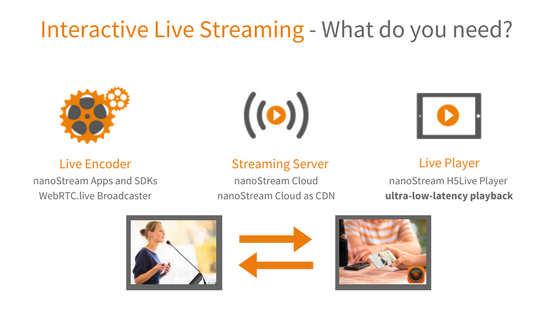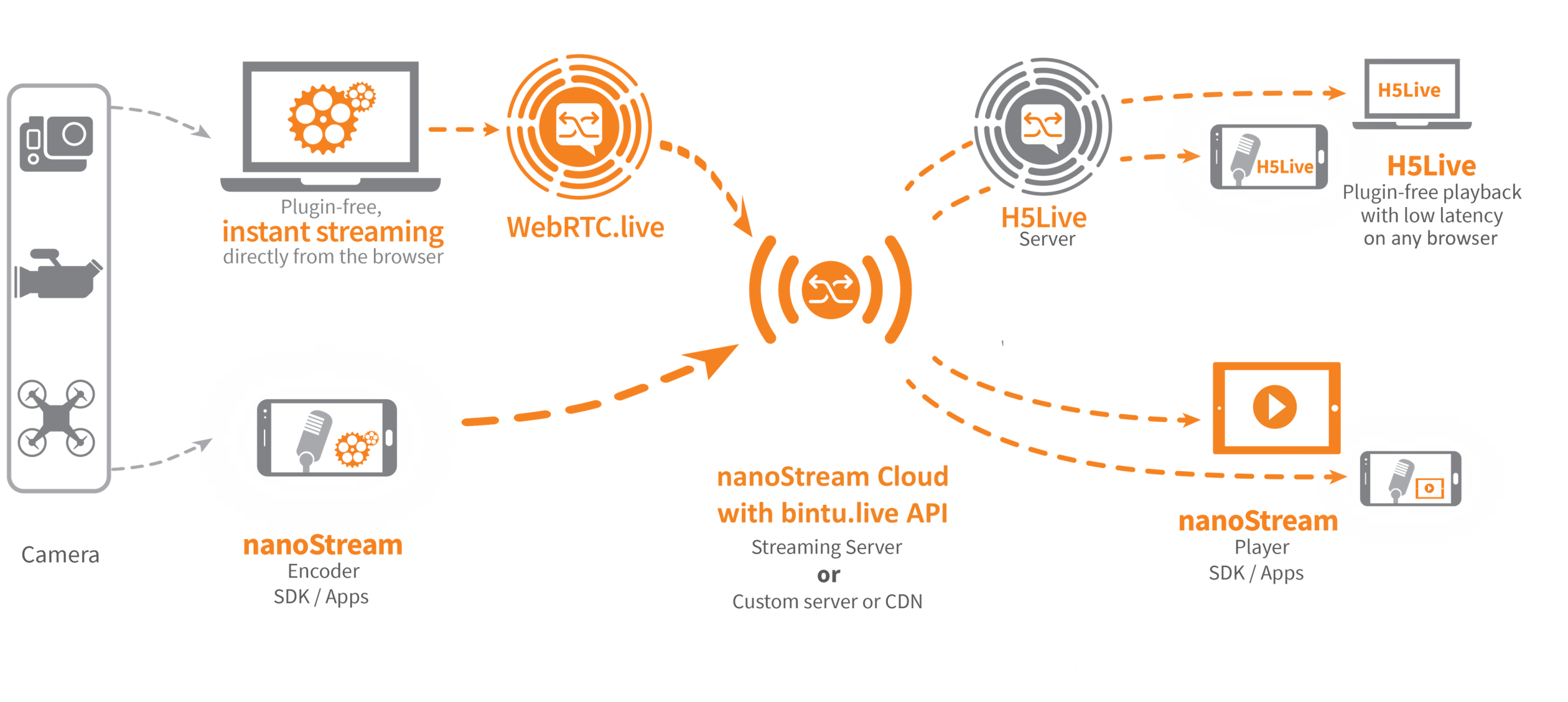Overview
In this article you will learn which tools you need for Live Encoding of Audio/Video streams and ingest to nanoStream Cloud, to be able to deliver live streams in ultra-low-latency to all devices with nanoStream H5Live Player.
– Native apps: RTMP/H264/AAC
– Migration from Flash broadcasters (RTMP/H264/Speex)
– Plugin-Free Live Encoding with WebRTC
nanoStream Cloud is exciting live streaming users around the world with the possibility of promoting scalable ultra-low-latency live streams on ALL browsers, including Safari on iOS.
Well, who wouldn’t feel amazed by such a technology? It is also plugin-free, HTML5-based and cross-platform!
With the increasing requests for nanoStream Cloud, some technical questions about codecs and streaming format came up, and we want to answer these questions. Let’s have a look:
General workflow

To create a live stream from a camera, you need a Live Encoder. It sends a live stream to a server in nanoStream Cloud, which does the delivery in ultra-low-latency to your audience and playback with nanoStream H5Live.
Codec and format questions, restreaming and transcoding
Basically all playback platforms, hard- and software nowadays support H264 video and AAC audio for playback of live streams. When using H264/AAC on the encoder side and RTMP as a streaming protocol, you can avoid transcoding overhead on the server but just pass through the encoded content. For delivery, a repackaging instead transcoding is a rather lightweight operation. This “passthrough streaming” approach enables higher scalability than using a lot of transcoding power on the server. nanoStream H5Live directly supports RTMP ingest and passthrough streaming with H264 and AAC to all browsers with low overhead.
Supporting ultra-low-latency live encoding / ingest
Live encoding is still based on RTMP in most setups, with Live Encoder hard- and software using RTMP as an upstream protocol to send a live stream in low-latency to the media server or CDN. Here are your options when looking for a live encoder to power your nanoStream Cloud workflow:
- nanoStream Live Encoder: simple and reliable! The Apps and SDKs are fully compatible with H264/AAC/RTMP setups, nanoStream Cloud and H5Live
- 3rd party live encoder: use existing 3rd party soft- or hardware for H264/AAC Live Encoding (FMLE, Wirecast, or hardware-based live encoder devices…)
- nanoStream WebRTC.live: browser-based live encoding/publishing for WebRTC-enabled browsers, easily added to nanoStream Cloud
On the delivery/player side, The nanoStream H5Live Player easily connects to your live stream via nanoStream Cloud for ultra-low-latency live playback on all HTML5 browsers on any device!
Migration from Flash-based broadcasting applications
Legacy web applications based on Flash are based on RTMP streaming. The RTMP usually contains a video and an audio track, both encoded with a separate codec. For live video and audio playback (decoding), H264 video and AAC audio have been available in Flash for many years. However, in Flash based broadcasting (publishing) applications, you can not use AAC audio, but need to rely on the outdated Speex or Nellymoser formats. To migrate to HTML5-compatible AAC audio, you have these options:
- Keep using your legacy Flash publisher: convert (transcode) the audio track from Speex to AAC. This can be transparently done with nanoStream Cloud servers, for delivery and playback
- Change your live encoding architecture to native H264/AAC. This can be done with a native app, either with our ready nanoStream Apps or SDKs, which both send H264 video, AAC audio in an RTMP stream
- Browser-based Live Encoding / Publishing with WebRTC.live.
It is important to note that WebRTC supports H264 video for passthrough streaming, but also uses a different audio format called “Opus”, which also requires audio transcoding to deliver H264/AAC to all clients. This is seamlessly possible with nanoStream Cloud

Are you still having questions? These articles might help you:
Interactive live streaming with ultra-low-latency
Live streaming cloud: how you can send your live streams around the world in 1 second!
